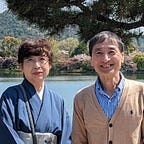An Intimate Exploration into Kyoto: Serene Solitudes & Timeless Tales
— Article 1: Lesser Known Gems —
I had the privilege of residing in Kyoto between 2021 and 2023. During these unprecedented times, Kyoto stood unbelievably quiet, its usual bustle muted by the pandemic. While my heart goes out to those affected, this silence gave me a unique opportunity: the privilege to capture thousands of photographs without the usual crowds of tourists, allowing for thoughtful compositions and unhurried moments. Since Kyoto typically welcomes over 50 million visitors annually, this serene solitude was nothing short of a miracle. I am eager to share these images with both lovers of Kyoto and those who plan to visit in a series of blog posts.
In this inaugural piece, I will spotlight two lesser-known gems: the Rurikoin and Hokyoin temples.
Rurikoin, while a favorite among the locals (a tidbit I serendipitously discovered at a traditional Japanese bar), is often overshadowed in the spring by its autumnal beauty. Yet, as my photographs will attest, spring in Rurikoin has its ethereal charm. The ideal periods to immerse oneself in the beauty of Rurikoin are from late March to mid-April and again from mid to late November.
A picturesque hill path leads from Rurikoin to other celebrated sites such as the Shugakuin-Rikyu, a historic imperial villa, and the Manjuin temple, whose origins trace back to the 8th century.
Founded in the 14th century, the Hokyoin temple is another treasure. My initial photograph showcases its wooden architecture, housing a sacred Buddha statue and almost resolving into the Autumn leaves. Subsequent images offer glimpses from within. The optimal times to appreciate Hokyoin largely mirror those of Rurikoin, with two exceptions: the spring season at Hokyoin begins a week earlier, and its autumn season starts a week later.
From Hokyoin, a scenic route meanders beside the renowned Arashiyama hill and through the famed bamboo forests, culminating at the Tenryuji temple — a World Heritage site — and the Togetsukyo bridge.
Stay tuned for my forthcoming article, which will delve into “Tofukuji and its 25 subsidiary temples.”
A brief note about myself: I’m an information scientist and had been a professor at the University of Electro-Communications in Tokyo for 18 years till 2021. Subsequently, I spent two years at Kyoto Tachibana University before returning to UEC. Reflecting on my two years in Kyoto, it often feels more like a dream than a chapter from my life. Through these articles, I wish to reimmerse myself in that Kyoto experience. I invite you to join me on this journey as I pair captivating imagery with narratives detailing Kyoto’s illustrious history and contemporary rhythms.
